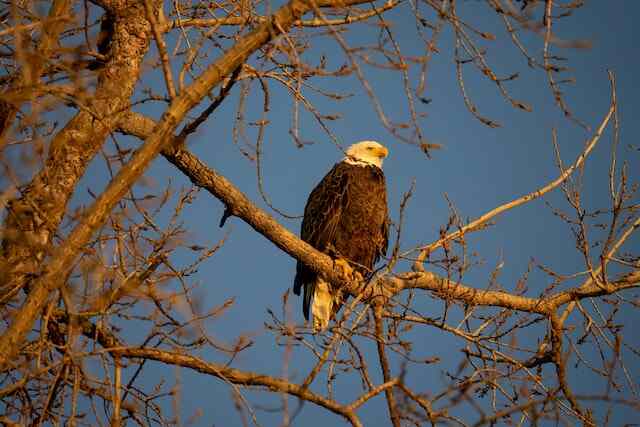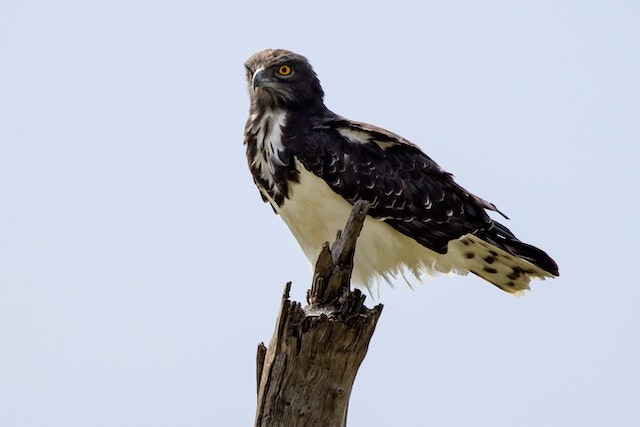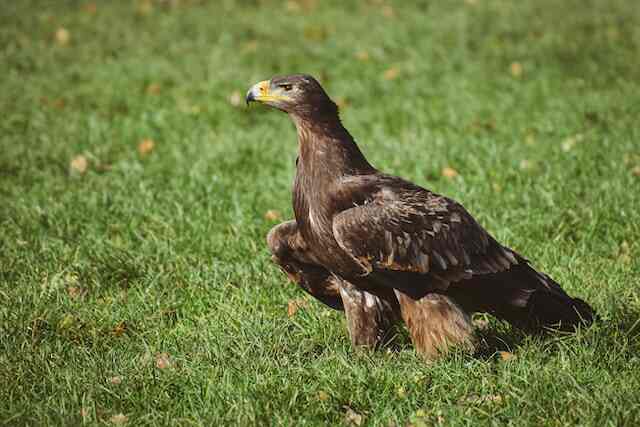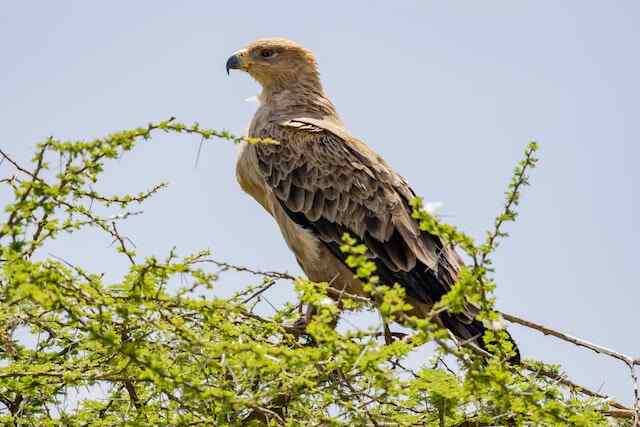Hey there, fellow adventurers of the wild! Brace yourselves for an exhilarating journey into the realm of eagles, those awe-inspiring birds of prey that have captivated our imagination for centuries.
As we spread our wings and embark on this quest, we’ll answer the burning question: Are eagles dangerous to humans? The short answer: No!
But get ready for an immersive experience that goes beyond myth-busting. We’ll delve into their majestic presence, remarkable hunting prowess, legal protections, and ongoing conservation efforts.
Along the way, we’ll uncover their fascinating behavior, cultural significance, and the incredible activities of eagle watching, photography, rehabilitation, and rescue.
By the end of this article, you’ll emerge with a comprehensive understanding of these regal creatures, empowering you to make informed decisions about your interactions with these magnificent birds.
So, let’s take flight and uncover the mesmerizing truths behind our winged companions of the sky!
Table of Contents
- 1 Key Takeaways
- 2 Overview of Eagles
- 3 Common Types of Eagles
- 4 Are Eagles Dangerous to Humans?
- 5 Legal Protection of Eagles
- 6 Eagle Conservation
- 7 Eagle Interactions with Other Animals
- 8 Eagle Behavior
- 9 Eagle Symbolism and Cultural Significance
- 10 Eagle Watching and Photography
- 11 Eagle Rehabilitation and Rescue
- 12 Frequently Asked Questions
- 13 Conclusion
- 14 Author
Key Takeaways
- Eagle attacks on humans are rare but can occur if they feel threatened or provoked.
- Factors that contribute to eagle attacks include territorial defense, protecting their young, and scavenging for food.
- Habitat preservation and reducing human disturbance in eagle habitats can help mitigate the risk of attacks.
- Conservation efforts are crucial for maintaining healthy ecosystems and recognizing the cultural and symbolic significance of eagles.
Overview of Eagles
Eagles are majestic birds of prey that belong to the Accipitridae family. They are known for their sharp talons, powerful beaks, and impressive wingspan.
Eagles are found all over the world, from the United States to Africa, Europe, and Asia. They can thrive in a variety of habitats, from forests and grasslands to deserts and wetlands.
Eagles are apex predators and are skilled hunters, using their keen eyesight to spot prey from high in the sky and their powerful talons to grasp and kill their prey.
They have a variety of hunting techniques, including soaring, circling, and stooping. Eagles are fascinating creatures that have captured the imagination of many people around the world.
In the subsequent section, we will explore some common types of eagles.
Common Types of Eagles
Various varieties of avian raptors, including the bald eagle and golden eagle, are well-known for their majestic appearance and predatory behaviors.
The bald eagle possesses a white head and tail with a brown body, while the golden eagle is known for its golden-brown feathers.
Both species can be found in North America, with the bald eagle being more prevalent in coastal regions, and the golden eagle found in mountainous areas.
These eagles are known for their impressive hunting techniques, such as stalking their prey from afar, swooping down from a great height, and diving at high speeds to catch their prey.
Their sharp talons and beak make them efficient hunters. While eagles may pose a threat to smaller animals, they are not typically dangerous to humans unless provoked or threatened.
Moving to the next topic, it is important to examine whether eagles pose any danger to humans.
Are Eagles Dangerous to Humans?
Eagles are known for their sharp talons and beaks, making many people wonder if they are dangerous to humans.
While it is rare for eagles to attack humans, it can still happen under certain circumstances.
Understanding the reasons for eagle attacks and ways to avoid them can help mitigate the risk of harm to humans.
Eagle Attacks on Humans
Instances of eagle attacks on humans are rare, but they can occur in certain circumstances. Eagles are generally not interested in attacking humans as they do not consider them as prey.
However, if they feel threatened or provoked, they may attack.
Eagle behavior and hunting patterns can also play a role in such attacks.
Eagles are known to be opportunistic hunters, and they may perceive a human as an easy target if they are carrying food or appear weak.
It is important to note that most of these attacks occur when humans encroach on the eagle’s territory or disturb their nests.
Therefore, it is advisable to maintain a safe distance from eagles and avoid disturbing their natural habitats.
In the next section, we will explore the reasons for eagle attacks in more detail.
Reasons for Attacks
Understanding the factors that contribute to eagle attacks can help mitigate potential risks and protect both human and eagle populations.
There are several causes that can trigger an eagle to attack a human, including territorial defense, protecting their young, and scavenging for food.
Eagles have keen eyesight and can perceive humans as a threat from a distance, leading to a preemptive attack.
Additionally, eagle attacks can occur when humans unknowingly encroach on their nesting areas.
To prevent such attacks, it is important for humans to be aware of their surroundings and avoid areas where eagles are known to nest.
Furthermore, implementing methods such as habitat preservation and reducing human disturbance in eagle habitats can help mitigate the risk of attacks.
Ways to avoid attacks include keeping a safe distance from eagles, being mindful of their behavior, and avoiding behavior that may be perceived as a threat.
By understanding the causes of eagle attacks and taking preventative measures, humans can coexist safely with these majestic birds.
Ways to Avoid Attacks
Although it is uncommon for eagles to attack humans unprovoked, it is important to be aware of ways to prevent attacks and identify signs of aggression.
One way to do so is by understanding eagle behavior and their preferred habitats. Eagles are territorial birds and may become aggressive if their territory is threatened.
Therefore, it is important to keep a safe distance and avoid disturbing their habitats.
Another way to prevent attacks is by avoiding feeding eagles, as this can cause them to associate humans with food and become more aggressive.
In addition, it is important to be able to identify signs of aggression, such as vocalizing, displaying their wings, or diving towards people. By recognizing these signs, individuals can take appropriate action to avoid an attack.
Overall, being aware of these preventative measures can help ensure a safe coexistence with eagles. Moving forward, it is important to also consider the legal protection of eagles and their habitats.
Legal Protection of Eagles
The legal protection of eagles is a contentious issue, with advocates arguing that the birds of prey play a vital role in their ecosystems, while opponents argue that the regulations surrounding eagle protection can be overly restrictive.
The bald eagle, for example, has made a remarkable recovery in recent decades due to hunting laws and habitat conservation efforts.
However, some argue that the current legal protections for eagles, which make it illegal to take, possess, or harm an eagle, are too strict and can hinder development projects.
Despite these debates, the conservation of eagle populations is crucial for maintaining healthy ecosystems.
The importance of eagle conservation is not only rooted in ecological considerations, but also in cultural and symbolic significance.
Eagles are revered in many cultures and symbolize freedom, strength, and resilience.
Thus, the legal protection of eagles must be carefully balanced with the need for development and economic growth, while also recognizing the critical role that eagles play in maintaining healthy ecosystems.
Eagle Conservation
Preserving and restoring the habitats of majestic birds of prey like the eagle is crucial for maintaining the delicate balance of our natural ecosystems.
The eagle’s habitat is a vital component of its survival, and conservation efforts have been put in place to ensure that the species continues to thrive.
Conservation efforts include habitat restoration, captive breeding programs, and education programs aimed at raising awareness about the importance of wildlife conservation.
One such program is the Bald Eagle Recovery and Monitoring Program, which has helped the bald eagle population recover from the brink of extinction.
The table below shows the number of breeding pairs of bald eagles in the United States from 1963 to 2019, highlighting the success of conservation efforts.
| Year | Number of Breeding Pairs |
|---|---|
| 1963 | 417 |
| 1973 | 791 |
| 1983 | 2,459 |
| 2019 | 9,789 |
Conservation efforts have not only helped the eagle population recover but have also benefited other species that share the same habitat.
However, despite these efforts, the eagle’s habitat is still under threat from human activities such as habitat destruction, pollution, and climate change.
Therefore, it is crucial to continue with conservation efforts and raise awareness about the importance of preserving the eagle’s habitat. In the next section, we will explore eagle interactions with other animals.
Eagle Interactions with Other Animals
Eagle interactions with other animals reveal a surprising fact: these birds of prey are known to prey on some of the most venomous snakes in the world, including the King Cobra, which has a venom potent enough to kill an elephant.
This is just one example of eagle predation, as they are also known to hunt a variety of other prey species including rabbits, squirrels, fish, and even other birds.
These interactions with prey species are a crucial aspect of eagle behavior, as they must be able to effectively hunt and capture their prey in order to survive.
Additionally, eagles can also compete with other predators for food, such as feral cats and coyotes.
Despite their impressive hunting abilities, eagles are not without their own predators, as they can fall prey to larger birds of prey such as Golden Eagles.
Understanding these complex interactions between eagles and other animals is a key aspect of conservation efforts for these majestic birds.
Eagle Behavior
Observing the behavior of eagles can reveal valuable insights into their hunting strategies and survival techniques. These birds of prey have a keen sense of sight and are known for their impressive hunting skills.
Eagles hunt mainly during the day and can spot their prey from a distance of up to two miles away. They swoop down at high speeds and use their sharp talons to catch their prey.
Eagles also have interesting nesting habits, building their nests high up in trees or on cliff ledges. They fiercely defend their nests and will attack any potential threats, including humans who venture too close.
Overall, eagle behavior is fascinating to study and provides a better understanding of these impressive birds.
As we move into the next section about eagle symbolism and cultural significance, it is important to note that the behavior of these birds has been admired and revered by people from various cultures throughout history.
Eagle Symbolism and Cultural Significance
Eagle behavior is not the only aspect that makes these birds fascinating. The eagle has been a symbol of power, freedom, and courage in many cultures throughout history.
In mythology, eagles were often associated with gods or used as messengers between the gods and humans.
Native American tribes, for example, saw the eagle as a spiritual creature that could soar to great heights and communicate with the divine.
The bald eagle, specifically, has become a national symbol of the United States, representing the country’s strength and independence.
To further highlight the significance of the eagle in culture and society, here is a table showcasing a few examples of how the eagles symbolism has been represented in different contexts:
| Context | Representation |
|---|---|
| Ancient Greece | Zeus’ messenger |
| Native American | Spiritual messenger |
| United States | National bird |
| Roman Empire | Military symbol |
| Egyptian | Protector of the pharaoh |
As we delve into the next section on eagle watching and photography, it is important to recognize the cultural significance of these birds, and how their symbolism has endured throughout history.
Eagle Watching and Photography
Eagle watching and photography are two popular activities among nature enthusiasts.
If you’re interested in observing these majestic birds in their natural habitats, you may want to consider visiting some of the best places to see eagles.
Additionally, if you’re looking to capture stunning images of eagles in flight, there are several tips and techniques you can use to enhance your photography skills.
Best Places to See Eagles
Unsurprisingly, there are numerous locations throughout North America where one may have the fortune of witnessing the majestic sight of these impressive birds of prey.
Some of the most scenic locations to view eagles include the Skagit River in Washington State, the Klamath Basin National Wildlife Refuge in California, and the Upper Mississippi River National Wildlife and Fish Refuge in Minnesota.
Guided tours are also available in many areas, providing a wealth of knowledge about the eagles’ behavior and habitat.
When visiting these locations, it is important to remember to respect the eagles’ space and avoid disturbing them.
With patience and a bit of luck, visitors may even witness the breathtaking sight of an eagle swooping down to catch its prey.
As one immerses oneself in the beauty of these powerful creatures, it is only natural to want to capture the moment.
In the following section, we will discuss some helpful tips for photographing eagles without disturbing their natural behavior.
Tips for Photographing Eagles
As we have discussed earlier, the best places to see eagles are often located in remote, natural habitats. If you are lucky enough to spot one of these majestic birds, you may want to consider capturing the moment with a photograph.
However, photographing eagles can be a challenge due to their quick movements and tendency to fly at high altitudes. To get the best shot, there are several tips and techniques you can use.
First, it is essential to have the right equipment and settings. A telephoto lens with a focal length of at least 300mm is recommended, along with a fast shutter speed and a wide aperture.
Additionally, it is best to shoot in manual mode to have more control over the exposure. Another important tip is to focus on the eagle’s eye, as this will draw attention to the bird’s natural beauty.
Finally, it is crucial to respect the eagle’s habitat and not disturb or provoke the bird in any way. By following these tips, you can capture stunning images of eagles in their natural habitat.
In the next section, we will discuss the importance of eagle rehabilitation and rescue efforts.
Eagle Rehabilitation and Rescue
Rehabilitation and rescue organizations play a crucial role in the protection and rehabilitation of injured or orphaned eagles.
These organizations are dedicated to conservation initiatives, habitat preservation, community education programs, research initiatives, breeding programs, eagle release programs, veterinary care, and the overall welfare of eagles.
In order to achieve these goals, they rely heavily on volunteers, donations, and partnerships with various government agencies and other organizations.
Their efforts have been successful in increasing the eagle population and ensuring their survival.
Furthermore, their work has helped educate the public about the importance of preserving these majestic birds and their habitats.
By supporting eagle rescue and rehabilitation efforts, we can help ensure that these magnificent creatures continue to soar freely in our skies.
Frequently Asked Questions
How fast can eagles fly?
Eagles can soar up to 120-160 km/h (75-100 mph), making them one of the fastest birds in the world. Their flight patterns vary depending on the species and their prey. This information is useful for bird enthusiasts and researchers alike.
What do eagles eat?
Eagles are opportunistic predators with a diverse diet consisting of fish, small mammals, and birds. Their hunting strategies involve aerial attacks, stealth, and scavenging. Their prey provides high nutritional value for their survival and reproduction.
How long do eagles live?
The average lifespan of eagles varies by species and habitat requirements. For example, bald eagles can live up to 20 years in the wild. Eagles are not typically dangerous to humans, but caution should be exercised around their nests.
Can eagles swim?
Eagles are powerful swimmers and have been known to dive into water to catch fish with their sharp talons. However, they can also encounter water safety issues, such as becoming weighed down by soaked feathers.
How do eagles mate and reproduce?
As the saying goes, “Birds of a feather flock together”. Eagle reproduction involves a courtship display, followed by copulation and nesting habits. The male and female work together to build a nest and care for their young.
Conclusion
Eagles are majestic birds of prey that have captured the admiration of humans for centuries. They are known for their impressive wingspan, sharp talons, and powerful beaks. Eagles are divided into two groups: sea eagles and booted eagles.
The common types of eagles include the Bald Eagle, Golden Eagle, Harpy Eagle, and African Fish Eagle.
While eagles are known for their impressive hunting skills, they are not typically dangerous to humans.
Eagles are generally shy and avoid confrontations with people. However, there have been rare instances where eagles have attacked humans, usually in defense of their nests.
It is important to respect eagles and their habitat and to keep a safe distance when observing them in the wild.
Eagles are protected by law in many countries due to their cultural significance and ecological importance.
Conservation efforts have helped to increase eagle populations in some areas. Eagles also hold symbolism in many cultures, representing strength, courage, and freedom.
Eagle watching and photography have become popular activities, allowing people to appreciate these magnificent birds in their natural habitat.
In cases where eagles are injured or in need of help, rehabilitation, and rescue programs exist to provide care and support.
In conclusion, eagles are fascinating creatures that hold a special place in human culture and ecology. While they may be feared by some, eagles are not typically dangerous to humans.
Their legal protection and conservation efforts have helped to increase their populations in some areas.
Eagles hold deep symbolism in many cultures, representing important values such as freedom and strength.
By respecting eagles and their habitat, we can continue to appreciate and learn from these magnificent birds.









